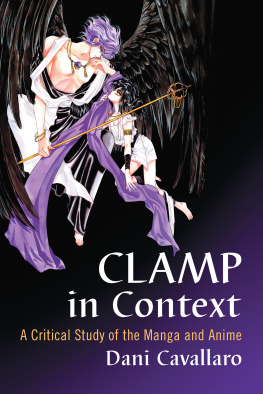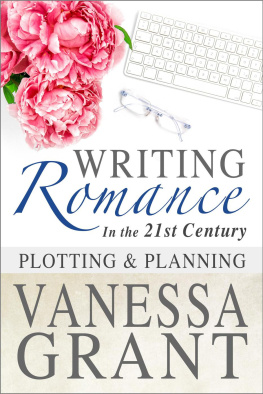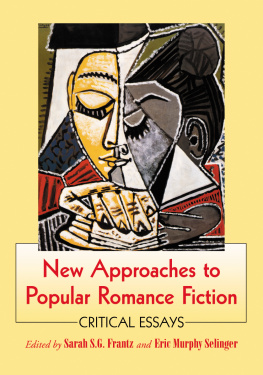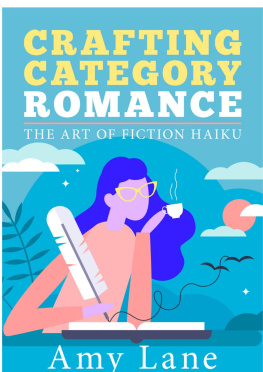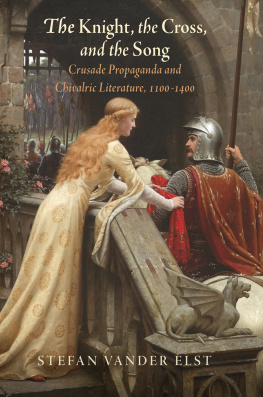Also by DANI CAVALLARO
The Late Works of Hayao Miyazaki: A Critical Study, 20042013 (2015)
Hayao Miyazakis World Picture (2015)
Synesthesia and the Arts (2013)
Japanese Aesthetics and Anime: The Influence of Tradition (2013)
Kyoto Animation: A Critical Study and Filmography (2012)
CLAMP in Context: A Critical Study of the Manga and Anime (2012)
Art in Anime: The Creative Quest as Theme and Metaphor (2012)
The World of Angela Carter: A Critical Investigation (2011)
The Fairy Tale and Anime: Traditional Themes, Images and Symbols at Play on Screen (2011)
The Mind of Italo Calvino: A Critical Exploration of His Thought and Writings (2010)
Magic as Metaphor in Anime: A Critical Study (2010)
Anime and the Visual Novel: Narrative Structure, Design and Play at the Crossroads of Animation and Computer Games (2010)
Anime and the Art of Adaptation: Eight Famous Works from Page to Screen (2010)
The Art of Studio Gainax: Experimentation, Style and Innovation at the Leading Edge of Anime (2009)
Anime and Memory: Aesthetic, Cultural and Thematic Perspectives (2009)
Anime Intersections: Tradition and Innovation in Theme and Technique (2007)
The Cinema of Mamoru Oshii: Fantasy, Technology and Politics (2006)
The Anim Art of Hayao Miyazaki (2006)
The Chivalric Romance and the Essence of Fiction
Dani Cavallaro

McFarland & Company, Inc., Publishers
Jefferson, North Carolina
LIBRARY OF CONGRESS CATALOGUING DATA ARE AVAILABLE
BRITISH LIBRARY CATALOGUING DATA ARE AVAILABLE
e-ISBN: 978-1-4766-2358-0
2016 Dani Cavallaro. All rights reserved
No part of this book may be reproduced or transmitted in any form or by any means, electronic or mechanical, including photocopying or recording, or by any information storage and retrieval system, without permission in writing from the publisher.
Front cover: St. George and the Dragon, 1455, by Paolo Uccello (PicturesNow)
McFarland & Company, Inc., Publishers
Box 611, Jefferson, North Carolina 28640
www.mcfarlandpub.com
To Paddy, Hazza and Mordecai,
with protean love
I want to learn more and more to see as beautiful what is necessary in things; then I shall be one of those who make things beautiful.
Friedrich Nietzsche (1882)
Everyone who has approached the Arthurian legends with a view to finding out more about them is struck at once by their sheer breadth and complexity. Many turn away at this point, or content themselves with reading Sir Thomas Malorys Le Morte dArthur. Wonderful though Malorys retelling of the legend is, it is only one among many. To have failed to discover the fourteenth-century poem of Sir Gawain and the Green Knight, or the mysterious pageantry of the Vulgate Version [i.e., Lancelot-Grail Cycle] from which Malory himself drew extensively, is to have missed a wondrous experience.
John Matthews (1993)
It must not be supposed that, when realism informed the upper regions of literature, the fantastic was not to be found on the printed page.... Beneath the rational carapace, there was always an imaginative substratum in literature.... And so, to use Professor Tolkiens phrase, the road goes ever onward.... The legends, it seems, will always be a perennial topic of fascination.
Ronan Coghlan (1993)
Preface
Chivalric romances are intrinsically acenteredor centerlesstexts. As such, they call into question the viability of any controlling force meant to enforce the authority of preestablished values.
Chivalric romances approximate fiction at its purest since they do not claim to house any truths. They thus epitomize the essence of all creative literature which is not ownedor colonizedby the ethos of classic realism.
This study focuses on the evolution of the chivalric romance from Chrtien de Troyes (late twelfth century) to William Shakespeares late plays (early seventeenth century). However, its argument is of immediate relevance to contemporary culture, insofar as it aims to show how the chivalric romance exemplifies an attitude to the world which would greatly benefit present-day citizens and consumers. This is because its centerless structure enables the form to yield a radical examination of the seats of meaning and truth which all societies, in varying degrees, require their members to embrace without reflection or doubt.
It may be tempting, in this regard, to assume that the postmodern text is akin to the type of text characteristic of the chivalric romance. In fact, the two are not the same. The postmodern text is inscribed in a culture of endless recycling where nothing truly new is produced, and the best one can expect is a travesty of novelty. This is a culture of simulacra: surfaces which hide not a secret presence but an absence: the lack of any substance, sense, or indeed identity.
The text associated with the chivalric romance, by contrast, experiments not with an army of entrenched simulacra, but rather a string of intriguing dissimulations. These issue from a playful juggling with actual and apparent meanings redolent of the actions performed by the eiron of ancient drama (the root of the word irony): a figure whose function is to urge the spectator to question the accepted truth by refusing to take anything at face value. Thus, the chivalric romance offers a mobile world of oppositions without asserting any given principles in a definitive fashion. It asks us, its readers, to make decisions and, where relevant, to act accordingly. Intrinsic to its world view is Socratic irony itself as a denial of conclusive solutions.
The present study proposes that irony constitutes the chivalric romances motivating force. Irony, in this context, is understood as a philosophical concept and as an attitude to the world rather than a mere trope. The books main goal is to bring to light the strategies through which the chosen texts engage with irony at both the literal and the metaphorical levels.
In Part I, the book undertakes a twofold task. Chapter One, Genesis, explores the evolution of the chivalric romance with reference to a selective survey of Arthurian lore. Chapter Two, Form and Structure, examines the salient stylistic traits and thematic predilections evinced by the form, in contradistinction with the epic, and the chanson de geste in particular.
Part II provides an in-depth investigation of a range of texts produced between the twelfth and the seventeenth centuries, focusing on their themes, imagery, narrative strategies, and methods of characterization. The leading thread running through Part II is the proposition that the chivalric romance serves a major social function, as both a cherished mode of entertainment, and a fictionalized expression of particular cultural preoccupations. This renders it a versatile vehicle for the exploration of philosophical issues of far-reaching relevance. Since, as emphasized above, the principle of irony is pivotal to the chivalric romance, special attention is given to how the chosen texts engage with this important idea.
The range of authors and texts covered in chapters Three to Five is outlined below.
Chapter Three: Chrtien de Troyes: Yvain, or, the Knight of the Lion; Lancelot, or, the Knight of the Cart; Perceval, the Story of the Grail; Lancelot-Grail Cycle (selection).
Next page

